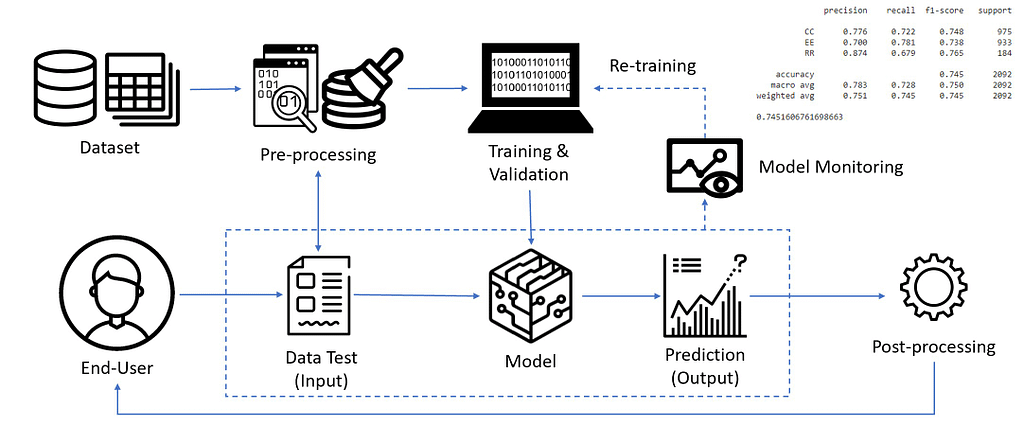Artificial Intelligence 101: an introduction
- February 24, 2022
- Categories: Artificial intelligence
These past few years, EENA has already published a series of papers and articles with tangible examples of how AI is being applied in Public Safety.
However, AI is constantly developing, bringing about a series of new possibilities every day. This article aims to shed some light on the art of possibility, the basic concepts of AI for first responders, and give public safety professionals some ideas on where they could start this journey.
Artificial Intelligence and its branches: What is it?
AI itself is a very conceptual term. According to Andrew Moore from Carnegie Mellon University:
“Artificial Intelligence is the science and engineering of making computers behave in ways that, until recently, we thought required human intelligence.”

Machine Learning: The study of computer algorithms that allow computer programs to automatically improve through experience.
This means giving computers the ability to achieve certain tasks without having been explicitly programmed for them. This is achieved through experience, allowing the computer to make calculated guesses based on previous scenarios.
Some examples include Supervised Learning (e.g. generating predictions of how the stock market would evolve), Unsupervised Learning (e.g. generating real-time recommendations) or Reinforcement Learning (e.g. robot navigation).
Voice: The capacity of computers to “hear” a sound.
This is present mainly in speech recognition and voice-to-text applications (e.g. dictating by voice your WhatsApp message).
Image: The capacity of computers to “see” and understand images or videos.
This allows computers to understand their environment by detecting objects or people. These sorts of algorithms can be found on our phone’s Image Lock features or self-driving cars and drones.
Natural Language Processing: The capacity to understand the inherent way in which humans communicate with one another, often ignoring language and grammar rules, which may have different meanings or even be based on non-verbal/direct communication.
This field often deals with issues related to Voice Recognition and the two are often discussed as the same. But a perfect example of natural language processing would be Sundar Pichai’s demo at Google I/0 presenting the Google Assistant.
Expert Systems
Expert systems are one of the oldest ways of applying AI. It works when a computer is given a set of rules and knowledge (inference rules & knowledge base) to be applied to very particular challenges. An example of a great application includes computer-assisted diagnostic tools, such as Mycin for infectious diseases and DXplain for general medicine.
Robotics
This is a very transversal line of work, which often includes many of the previously mentioned branches. It refers to the different disciplines that contribute to building robots and allow them to make decisions, perform tasks or navigate our physical environment.
These branches are great examples of how technology is evolving to solve complex problems. But this is merely a summary of the current ongoing work and it is constantly evolving and growing.
Learning: the base of any AI
Independently from whatever branch we are talking about, possibly the most important takeaway from this article is understanding how AI models are built and how relevant data is in the process.

- Specific Challenge: Before you start researching, developing, etc., the challenge must be very well defined and scoped. This is crucial to obtain quality results instead of random outputs.
Example: Baking cookies for breakfast. Baking is too broad, and you could end up with any sort of dish. Instead, baking cookies gives you a specific goal.
2. Datasets: To train the algorithms, you will need data about the previously defined challenge. Datasets are groups of organised and accessible data that you can use to perform analytics analysis. The more data you can collect, the more precise and richer your model will be.
Example: Datasets would refer to ingredients like flour, sugar or chocolate.
3. Algorithms: Once you know which data you have available to solve your challenge, then comes the selection of the adequate algorithm from the many branches we described.
Example: The algorithm would be a recipe to bake cookies based on the available ingredients (data) you have.
4. Models: Training the algorithm with data will generate models. These models can generate outputs (e.g. recommendations, a decision…) with a certain level of accuracy. The more relevant the data, the more accurate your predictions will be. However, it is important to note that the level of acceptable accuracy is decided by yourself.
Example: The model would be the cookies generated at the end. Their quality will depend on the ingredients (data), your recipe (algorithm) and your standards for what makes a good cookie.
Once you achieve an acceptable model, then comes the implementation piece. This refers to developing a feature to implement this model on your Control Room software, car, phone operating system, etc. This step is also crucial since it is not simply about investing development time. Having a clear understanding of the feature design is key to ensuring end-users truly benefit from it. Otherwise, we risk the new feature becoming a burden instead of beneficial to the end-user. For example, a control room software recommendation that’s hard to read or comes with a flashing light that distracts call takers.
To conclude:
AI is proving to be very beneficial to many areas, including Public Safety. A clear understanding of where technology is evolving, and how AI is created can help a public safety organisation pave the way towards adopting this sort of capacity. The most important piece to get started with is properly mapping out challenges that need to be solved and understanding how to generate data in an accessible way to collaborate with technology developers.
Relevant links
https://www.analyticssteps.com/blogs/6-major-branches-artificial-intelligence-ai
https://dl.acm.org/doi/book/10.5555/1096485 (Mycin)
https://jamanetwork.com/journals/jama/article-abstract/366898 (DXplain)
The opinions expressed are those of the authors and do not necessarily represent the views of EENA. Articles do not represent an endorsement by EENA of any organisation.

Alfonso Zamarro
- Alfonso Zamarro#molongui-disabled-link
Share this blog post on:
